Volkswagen ID.Buzz Review 2025: Price, specs & boot space
Written by Andrew Brady
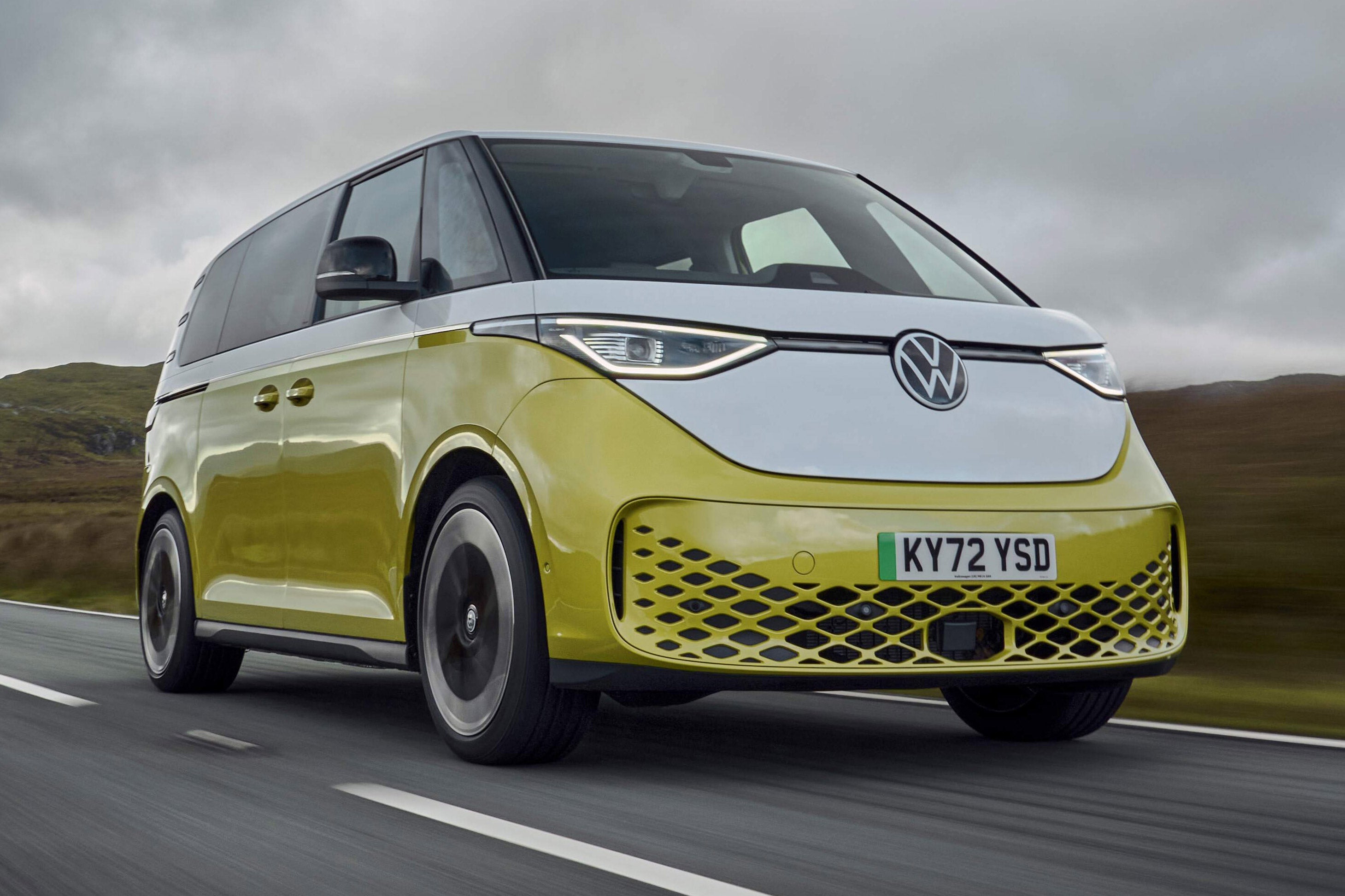
- 2022
- MPV
- EV
Find your perfect Audi with heycar
Quick overview
Pros
- Retro design really turns heads
- Bright, roomy and well-equipped cabin
- Comfortable and refined to drive
Cons
- Not the most versatile MPV
- Not the most affordable electric vehicle
- Irritating climate control buttons
Overall verdict on the Volkswagen ID.Buzz
"A modern take on the iconic hippy bus, the Volkswagen ID.Buzz is an electric people carrier that's so much more desirable than yet another family SUV. You'll pay a premium for Volkswagen's must-have electric car, and the ID.Buzz isn't quite as versatile as you might expect, but its charm and charisma make it a very desirable choice."
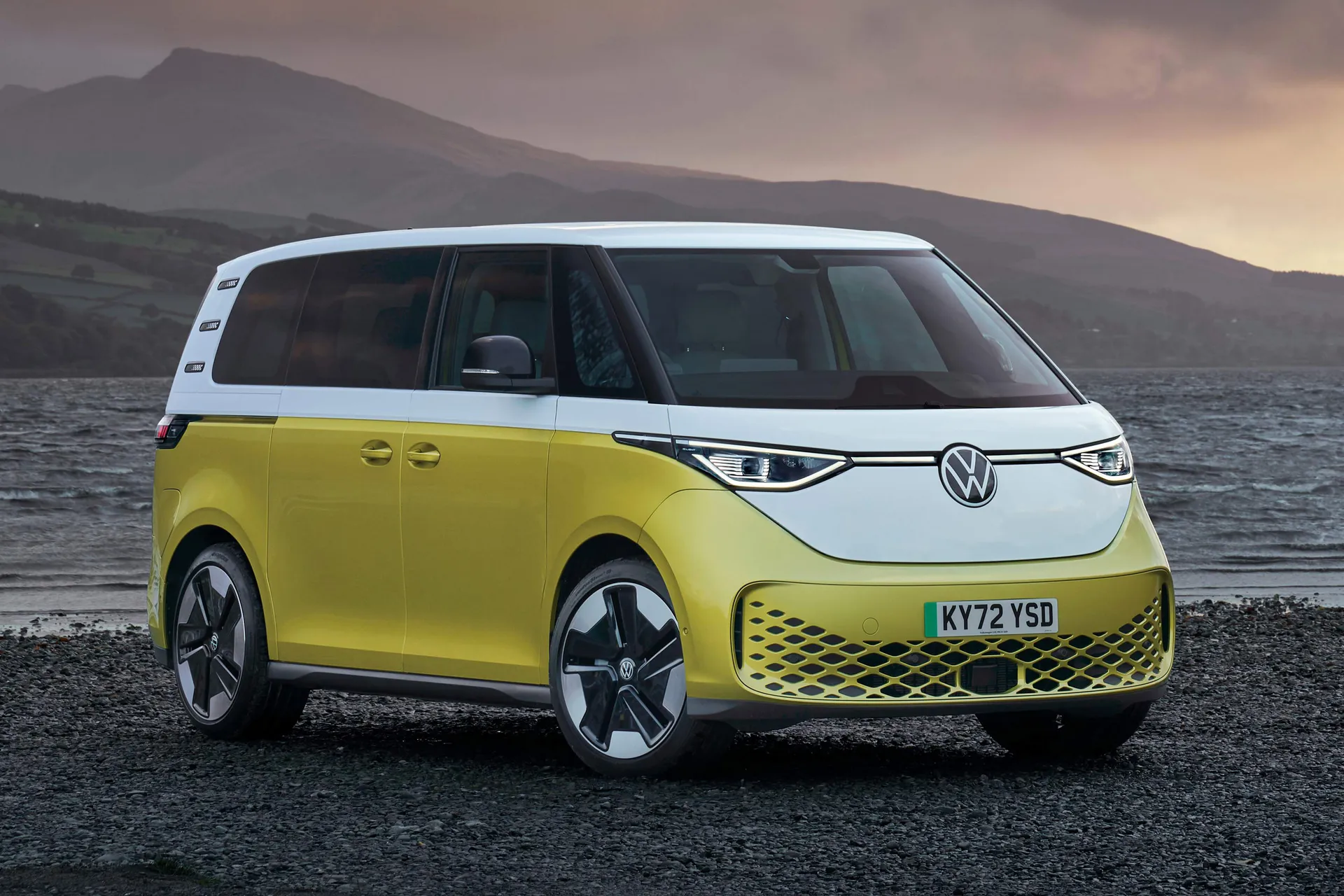
As you'll find out in our Volkswagen ID.Buzz review, it's a car that takes a similar approach to cars like the MINI Hatch, Fiat 500 and even the latest Land Rover Defender. Car buyers love a retro design, and there's arguably few more iconic than the old Volkswagen Type 2, also known as the VW Camper.
You can't buy a campervan version of the Volkswagen ID.Buzz (yet), but you can get it as an electric people carrier ( five-seat for the first coup,le of years, with a seven-seater arriving later in 2024) or in more utilitarian van form (badged the Volkswagen ID.Buzz Cargo). It's the former that we're focusing on in this Volkswagen ID.Buzz review, although we will provide a few insights into the commercial vehicle version here and there.
So what exactly is the Volkswagen ID.Buzz? Well, there's nothing else quite like it. It's based on the same platform as other electric ID-badged models (such as the Volkswagen ID.3, ID.4 and ID.5) and it's been designed from day one to be offered solely with electric power. That means it's different from other electric van-based people carriers like the Citroen e-Berlingo and Mercedes EQV.
In truth, the Volkswagen ID.Buzz is more of a style-led purchase rather than a functional one. And that means it's up against premium (read: 'expensive') electric SUVs: cars like the Jaguar I-Pace and BMW iX3.
With prices starting from around £60,000, it's fortunate that the ID.Buzz feels noticeably more upmarket than the likes of the Volkswagen ID.3 and ID.4. It's still not exactly plush inside, but there are some nice finishes and quirky features, although the irritating touch-sensitive climate control buttons that plague other VW electric cars are present here, too.
You sit high up in the Volkswagen ID.Buzz, with impressive van-like visibility. On the practicality front you get a simply enormous load space, plenty of passenger room and lots of neat storage touches in an airy, feel-good cabin environment. For its first couple of years on sale, the ID.Buzz was only available as a five-seater, and those seats weren't as flexible as they are in some MPVs. However, a long-wheelbase version with up to seven seats is available as of late 2024.
The electric motor powers the rear wheels and, while it doesn't surge forwards like a Tesla, the Volkswagen ID.Buzz is more than rapid enough for something that's essentially a commercial vehicle with extra seats. There's only one battery size (79kWh) available in the five-seater but, with an official range figure of 258 miles, that'll be sufficient for most buyers. The long-wheelbase model has more room for floor-fitted battery cells, so these have an 86kWh battery pack. The high-performance GTX version, also arriving in 2024, keeps the 79kWh battery, but adds a second electric motor to boost power output from 286PS (this was upgraded from 204PS in 2024) in the regular car to 340PS.
Ultimately, the Volkswagen ID.Buzz is a very desirable electric car that'll put a smile on the face of anyone who comes into contact with it. And, while you'll pay a premium for that (and it's not quite as versatile as a Volkswagen Multivan MPV), can you put a price on feeling good?
Looking for a used car for sale? We've got 100s of Volkswagen Approved Used Cars for Sale for you to choose from, including a wide range of Volkswagen ID.Buzz EVs for sale.
What's the best Volkswagen ID.Buzz model/engine to choose?
At launch the Volkswagen ID.Buzz range was not extensive, with only a couple of trim levels (although an additional high-value 1st Edition version was initially offered for a limited time) and one electric motor and battery pack size. In late 2024, that grew with the arrival of the long-wheelbase version with its bigger battery, and the GTX, with its more powerful twin-motor powertrain. At the same time, the electric motor in the regular version was upgraded from 204PS to 286PS.
For the passenger version, we'd say Life trim is plenty well equipped enough for most family and lifestyle buyers, although we'd understand if you went for Style trim, which adds some extra comfort and convenience features for a minimal extra outlay.
What other cars are similar to the Volkswagen ID.Buzz?
In some ways the Volkswagen ID.Buzz is quite unique. It's the first ground-up electric van or van-based MPV: pretty much every alternative is a formerly diesel van that's been adapted to use electric power. But it's also a very style-focused product, something which can't really be said about other similarly-sized vans or MPVs.
It could be cross-shopped, then, by buyers of electric SUVs looking for more outright space. Cars such as the Tesla Model Y and Audi Q8 e-tron. At the other end of the scale, there's noticeably cheaper - but more basic and lower range - electric passenger and cargo vans such as the Citroen e-Berlingo, Vauxhall Combo Electric and Peugeot e-Rifter. The long-wheelbase model, meanwhile, with up to seven seats, faces stiff competition in the form of the Mercedes-Benz EQV.
Comfort and design: Volkswagen ID.Buzz interior
"We really love the Volkswagen ID.Buzz's cabin when sat up front: it's bright, solid and a very nice place to sit. It's roomy in the rear, too, although there are some practicality criticisms that VW should probably address. "
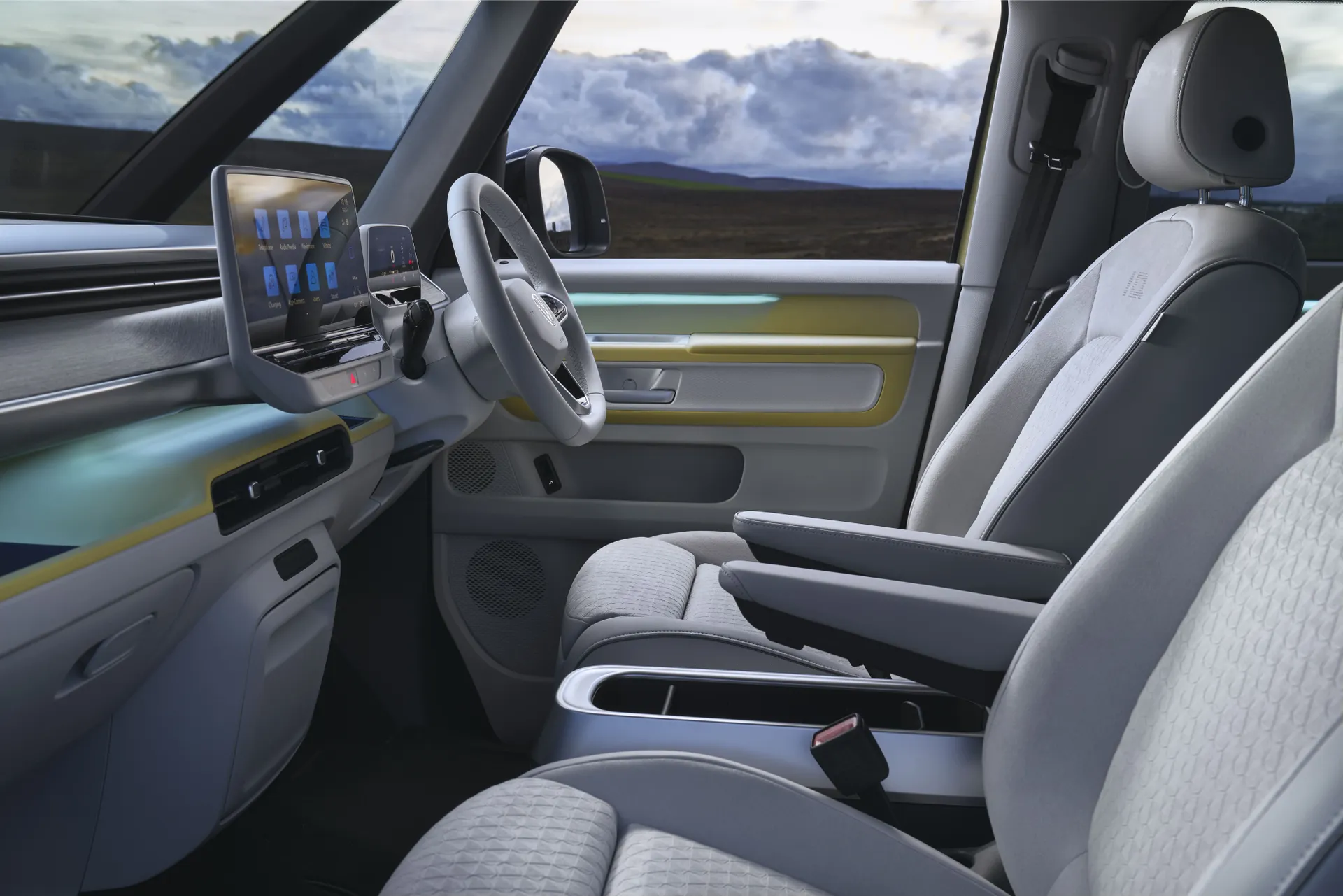
Sitting up front in the Volkswagen ID.Buzz feels like sitting in something between a full-size van and a family SUV. You don't sit as high as you would in a VW Transporter or Caravelle, but you are higher up than in an ID.4.
That raised driving position combines with big side windows and a tall, steeply raked windscreen for a fantastic view out. You also get small 'quarterlight' windows in the pillars to improve visibility at junctions. It's one of the most airy and pleasing cabin environments around, particularly with the bright colours of our passenger version and standard ten-colour ambient lighting (30-colour extended lighting is optional).
It's worth noting that the ID.Buzz Cargo van has darker, gloomier trim and a less special feel throughout, although that's reflected in the price. You still get that great view forwards, too, while the Cargo gets even more storage areas like a big dash-top compartment and extra cupholders.
Storage is still pretty good in the passenger version, though. You do without the big dash-top area, but there's still two bins on each door, rubber matted compartments within the dash centre, a good-size glovebox and a flip-out compartment featuring two cupholders. There's also the so-called 'Buzz Box', a large removable centre console with two further cupholders, a five-litre drawer, an ice scraper and even a bottle opener.
The seats themselves are very comfortable, too, with separate adjustable armrests that can be flipped up if you don't want to use them. Much of the control interface is identical to the other Volkswagen ID models, with the central infotainment screen on a separate plinth within your eyeline, a small digital dial display and a rocker control on the steering column to switch between drive, park and reverse.
One thing that may well be a source of frustration is that the rear windows don't open at all. Blame the sliding doors and the designer's desire for a clean, minimalist side profile for that. But if your kids want a bit of fresh air or your dog likes to stick its head out the window, you're fresh out of luck.
Quality and finish
We've been critical of the use of bland, hard plastics in the ID.3 and (to a lesser extent) the ID.4 and ID.5 before. So it's nice to see a mix of nicer materials in the Volkswagen ID.Buzz, in which fit and finish seems very good on initial impressions.
Sure, there are hard plastics across most of the door panels and the lower dashboard, but there are also proper padded door armrests, textured dash finishes, nice-feeling seat upholstery and - on the high-spec passenger models we've driven - a nice splash of wood trim across the dash top. Silver painted plastics on the dashboard and centre console also look a bit classier, too.
Furthermore, everything feels built to withstand hardcore lifestyle activities or many years of punishing family life. Even the flip-out cupholder cubby in the dash feels like it wouldn't break even if you tried. It's certainly not as luxurious as a Mercedes-Benz EQV, but it's not priced like that, either.
VW makes a lot of noise about the sustainability of the ID.Buzz. There is no leather or animal-sourced materials anywhere, with synthetic leather available along with recycled material for the carpets and headlining. Some fabrics also use 'Seaqual' material, which is recycled and partly made from plastics collected from the ocean.
Infotainment: Touchscreen, USB, nav and stereo in the Volkswagen ID.Buzz
The infotainment offering in the Volkswagen ID.Buzz is the now standard-issue touchscreen and digital dial combination you'll find on all ID. models. In all but the entry-level ID.Buzz Cargo, there's a 10.0-inch central display with built-in navigation: the cheapest Cargo Commerce does without sat-nav.
Optionally available on all passenger models is the Infotainment Package Plus, which brings a 12.0-inch touchscreen and enhanced voice control, but at more than £1,500, it's quite pricey for a modest upgrade. If you can find one on the used market, it did come as standard on the limited-run 1st Edition.
The standard system is largely fine anyway, with a reasonably responsive and bright display. It also doesn't seem to suffer with the loading lag and freezing issues that plagued early ID. models: thank over-the-air software upgrades for that. If you don't like the infotainment interface, you can use Apple CarPlay and Android Auto, which combines with a wireless phone charging pad neatly integrated into the dashboard.
Familiar complaints remain, however. The button-free approach means simple tasks are more of a faff than they should be. For example, adjusting the temperature using the touch sliders below the screen (which still aren't backlit at night) is hit-and-miss. The touch controls on the steering wheel are similarly irritating at times. It's all stuff you get used to, but VW used to be fantastic at making things super-easy, with well-placed physical buttons.
Like other ID. models the Buzz comes with 'Car2X' functionality. Basically, this will allow the car to communicate with the infrastructure around it to warn of upcoming hazards, while 'swarm data' (whatever that is) aids the car's partial self-driving systems.
The digital dial display - a standard 5.3-inch size on every version - is not the most feature-packed or clever, but tells you everything you need to know. The standard nine-speaker stereo (less in the Cargo) sounds decent enough, too, while there are a total of seven USB-C ports for devices dotted about the cabin (four in the Cargo). Also available to option is a 230-volt socket for powering electrical appliances, which will still operate when the vehicle is turned off.
Space and practicality: Volkswagen ID.Buzz boot space
On the face of it the five-seat VW ID.Buzz offers loads of space for a family. Taller drivers and front passengers are well-catered for, too, with plenty of legroom, tonnes of headroom and enough adjustment in the seats and steering wheel for all shapes and sizes. As with other ID. models, the digital dials move with the steering wheel, although you don't get electric seat adjustment (unless you find a 1st Edition car) and massaging is optional.
Open the sliding side doors (electrically opening as part of an option pack) and you'll find similarly generous space for three in the back. However, it's disappointing is that you only get a rear bench, rather than the three individual rear seats that most small van-based rivals come with. That reduces versatility, although the bench does split in two to allow either side of the bench to slide backwards and forwards depending on if you want to prioritise legroom or boot space. The backrests do recline, too, and three adults can get comfortable thanks to the lack of a transmission tunnel and plenty of space.
With all five seats in place, the Volkswagen ID.Buzz's boot capacity measures up to 1121 litres - that's measured up to the top point of the seatbacks - which is enormous. You'll also find padded armrests and cupholders built into the sides of the boot, even before the arrival of the seven-seat version.
The rear seats fold down to create a simply massive 2205-litre space. The seat folding isn't all that clever, leaving a sizeable hump where the bench base is. However, Volkswagen has a solution. On Style models and above, there's a height-adjustable and removable luggage floor called the Multi-Flex Board, which lines up neatly to create a totally flat bed (ready for a mattress - ID.Buzz Camper anyone?) with storage boxes underneath.
We haven't yet encountered a long-wheelbase seven-seater version, so we can't yet comment on how much (or how little) space there is for passengers in the third row. However, we do know that these seats can be folded or removed completely, and will all seven pews in place, the boot space available still totals 306 litres. There's an improved 1340 litre in five-seat mode, while with all rear chairs stashed, there's 2469 litres.
The Volkswagen ID.Buzz Cargo doesn't have any rear seats, instead it features two seats or a three-person bench up front and a fixed partition behind: this can be optioned with a window and an opening hatch. There's room for two Euro pallets inside, so we're told, but the 650kg maximum payload is well off the best traditional vans, and beaten by the electric Peugeot, Citroen and Vauxhall small vans.
In terms of exterior dimensions the Volkswagen ID.Buzz is 4712mm long, 1985mm wide (excluding mirrors) and 1927mm tall. It's a wide vehicle, then, but no longer than your average family estate car, despite a near three-metre wheelbase. The long wheelbase model is the same for width and height, but the length is 4962mm, and all of the extra 250mm has gone into the wheelbase.
Handling and ride quality: What is the Volkswagen ID.Buzz like to drive?
"The Volkswagen ID.Buzz offers a very pleasant and relaxing driving experience. It drives as well as its smaller siblings, and is perhaps even more comfortable."
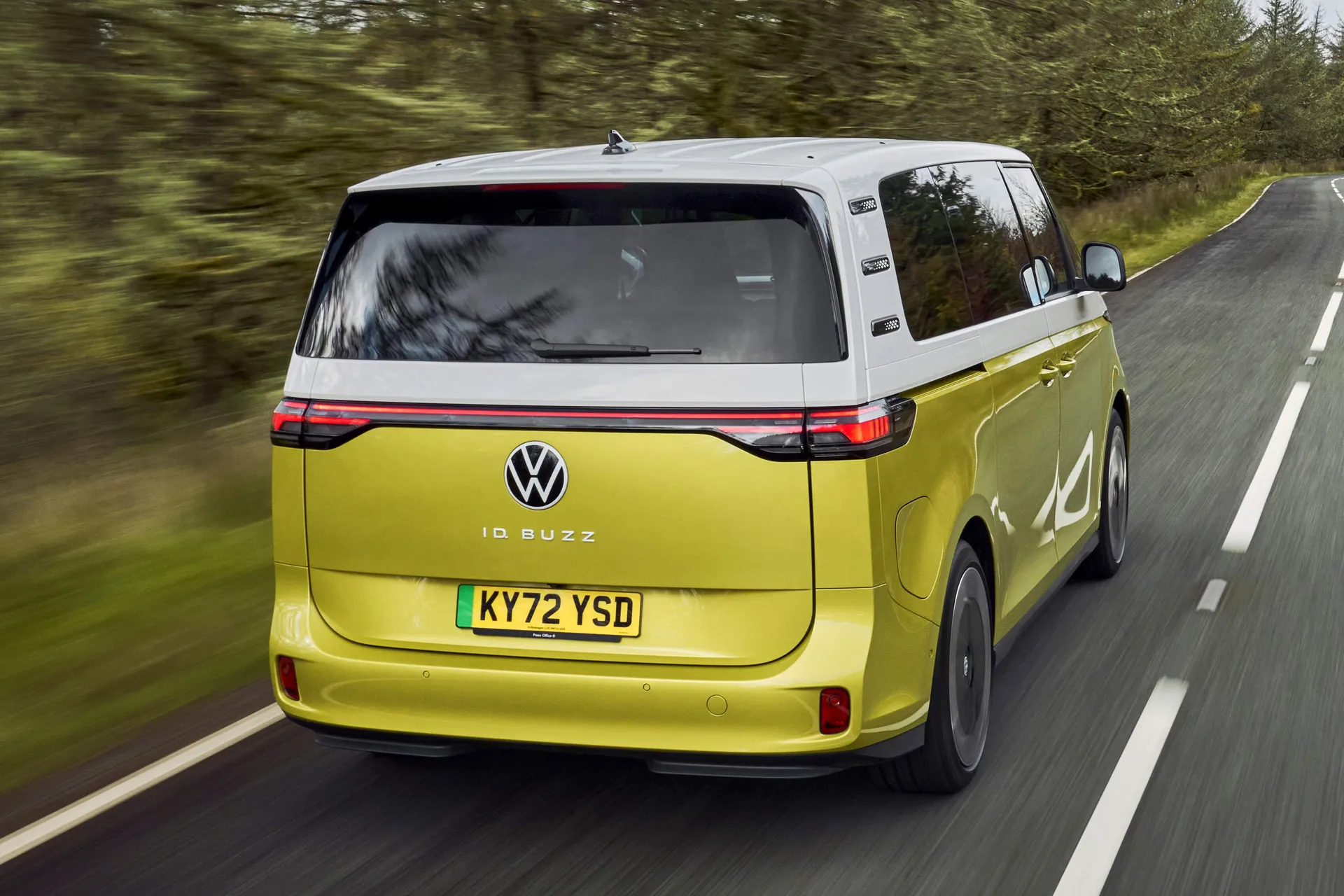
Next to the design and interior ambience, the Volkswagen ID.Buzz's driving experience is one of the best things about it. Compared to a diesel-powered equivalent it's massively more refined and relaxing on the road, and even handles pretty well.
Volkswagen is keen to point out that, despite weighing nearly 2.5 tonnes in high-spec passenger form, the ID.Buzz keeps most of its weight really low in the car with the battery pack and motor under the floor. That lowers the centre of gravity, which basically means it doesn't feel like it'll fall over in a stiff breeze or round a tight bend.
Far from it. In fact the ID.Buzz feels quite agile and composed. Around town its fairly tight 11.1-metre turning circle combines with great visibility and a wheel-at-each-corner stance to make it easy to thread through traffic, although being nearly as wide as a Range Rover means tighter London streets might be more challenging.
Parking isn't too hard, either. It's not much longer than a Skoda Octavia estate, but even easier to see out of. There are also front- and rear parking sensors and a reversing camera as standard even on the base Life model, although you don't get either of those on the base VW ID.Buzz Cargo.
Also added in higher-end versions of the passenger and Cargo versions is a clever memory function for the Park Assist system. The idea is that you can save a few different parking manoeuvres you commonly do, and by selecting one the car will be able to steer, brake and accelerate itself into the space. We haven't had a chance to try it yet, however.
Out of town, the Volkswagen ID.Buzz feels a lot like a bigger, softer ID.4. The steering isn't overly sharp but it's precise and accurate enough, while for something this tall and heavy, body lean isn't too pronounced. You really do forget you're essentially driving a van. This effect is particularly impressive in the Cargo version, which drives pretty much identically.
The ride is a real highlight, too. It manages to be soft and isolating without feeling too floaty or uncontrolled, and it didn't thump over the bumps we could find even with the 20-inch wheels fitted. We've also driven a Cargo model on 18-inch wheels that was seriously smooth.
All in all, we've not driven any electric van or van-based MPV that offers this level of refinement and comfort beyond the super-expensive Mercedes-Benz EQV.
What engines and gearboxes are available in the Volkswagen ID.Buzz?
To begin with, Volkswagen ID.Buzz came solely equipped with a 77kWh battery pack and a 150kW (204PS) electric motor powering the rear wheels. Torque is rated at a punchy 310Nm.
So equipped. the Volkswagen ID.Buzz can go from 0-62mph in 10.2 seconds and on to a limited top speed of 90mph. That might sound a bit slow, but it doesn't feel it, with the instant power delivery making for sprightly performance around town. There's enough punch for it to not feel underpowered on faster roads and motorways, either.
Frankly, it's all the performance we can see the majority of family buyers needing, and faster than most other electric MPVs. The same figure is quoted for the ID.Buzz Cargo, but it feels fractionally faster because it's a bit lighter with no rear seats and less equipment.
Some big changes happened in 2024. Regular five-seat versions stuck wityh the same 77kWh battery, but the power output of the rear-mounted electric motor increased to 286PS, quite the jump. We haven't tried it yet, but we'll update this review as soon as we do. The long-wheelbase seven-seater version also arrived, which used the same motor but increased battery size to 86kWh (the extra length means there's room gor more cells in the floor-mounted battery pack). The range-topping, high-performance GTX variant arrived at a similar time - available i both short- and long-wheelbase body styles, and this adds a second electric motor on the front axle to hike the power to 340PS.
Maximum range in the Volkswagen ID.Buzz
Despite being in essence an electric van, the Volkswagen ID.Buzz has a pretty slippery body, with a drag coefficient (aerodynamics rating) that's only slightly worse than an ID.4's.
It's still a bigger, heavier vehicle, though, so it can't quite match the ID.4's claimed maximum range of 322 miles. Still, the Volkswagen ID.Buzz's maximum range of 258 miles under WLTP testing is a very competitive figure, exceeding the bigger Mercedes-Benz EQV by 45 miles despite its smaller battery.
The VW ID.Buzz Cargo is a touch less aerodynamic and its range figure reduces ever so slightly to 256 miles. Either way, we saw around three miles per kWh on our test drive which took in motorways, A-roads and a bit of town driving. That equals a real-world range of 230 miles - far in excess of what you'd see out of Peugeot, Citroen and Vauxhall's electric vans/van-based MPVs. Even in the middle of winter, our ID.Buzz test car was returning 200 miles from a charge.
However, all that was before VW swapped the ID.Buzz's 204PS electric motor for a more powerful 286PS one, and we haven't yet seen technical specs for that version, so we don't know what effect it'll have on the car's range. That occurred at the same time as the introduction of the long-wheelbase version, which has a bigger battery, but also a bigger, heavier body. Still, official range figures are given at between 286 miles and 291 miles depending on trim, so a small improvement. We haven't yet seen range figures on the GTX version, so we'll have to wait and see on that one.
Refinement and noise levels
This is where the Volkswagen ID.Buzz has the edge over all of its van-based competitors, save perhaps the considerably more expensive Mercedes-Benz EQV. Underneath, all the mechanical and electrical bits are shared with other ID passenger models, which means you get the same impressive refinement levels as one of VW's electric cars.
From our experience so far, the ID.Buzz is impressively refined. There's very little wind noise for such a tall, high-sided vehicle, while road noise seems well isolated, too. The electric motor whine isn't very noticeable, either. In fact, it's as refined as a well-sorted electric SUV.
Safety equipment: How safe is the Volkswagen ID.Buzz?
The Volkswagen ID.Buzz features the same array of safety equipment as its smaller ID siblings, including front driver and passenger-, side-, curtain- and centre airbags, lane keeping assist, adaptive cruise control with Intelligent Speed Assist and Front Assist automatic emergency braking that'll also detect pedestrians and cyclists.
If you go for the entry-level ID.Buzz Cargo Commerce, you only get basic cruise control and lose the centre airbag because there is a three-seat front bench, but everything else remains. An optional Assistance Package Plus adds a number of further safety features including Lane Change Assist and Traffic Jam Assist.
Parking sensors all-round and a reversing camera are standard on the cheapest passenger ID.Buzz (there's no camera on the base Cargo), while there's the aforementioned Park Assist Plus with memory function to take your parking skills out of the equation entirely.
Of course there are ISOFIX child seat mounting points for the outer two rear seats, but not three as you might find in some electric MPVs such as the Citroen e-Berlingo. Even more disappointing is that there's no front ISOFIX point in the ID.Buzz at all.
The Volkswagen ID.Buzz has been awarded a very respectable five-star safety rating by Euro NCAP.
Charging times: How much does it cost to charge the Volkswagen ID.Buzz?
"Initially, the Volkswagen ID.Buzz was only available with one battery option, and those are the only ones we've seen charging speed data for."
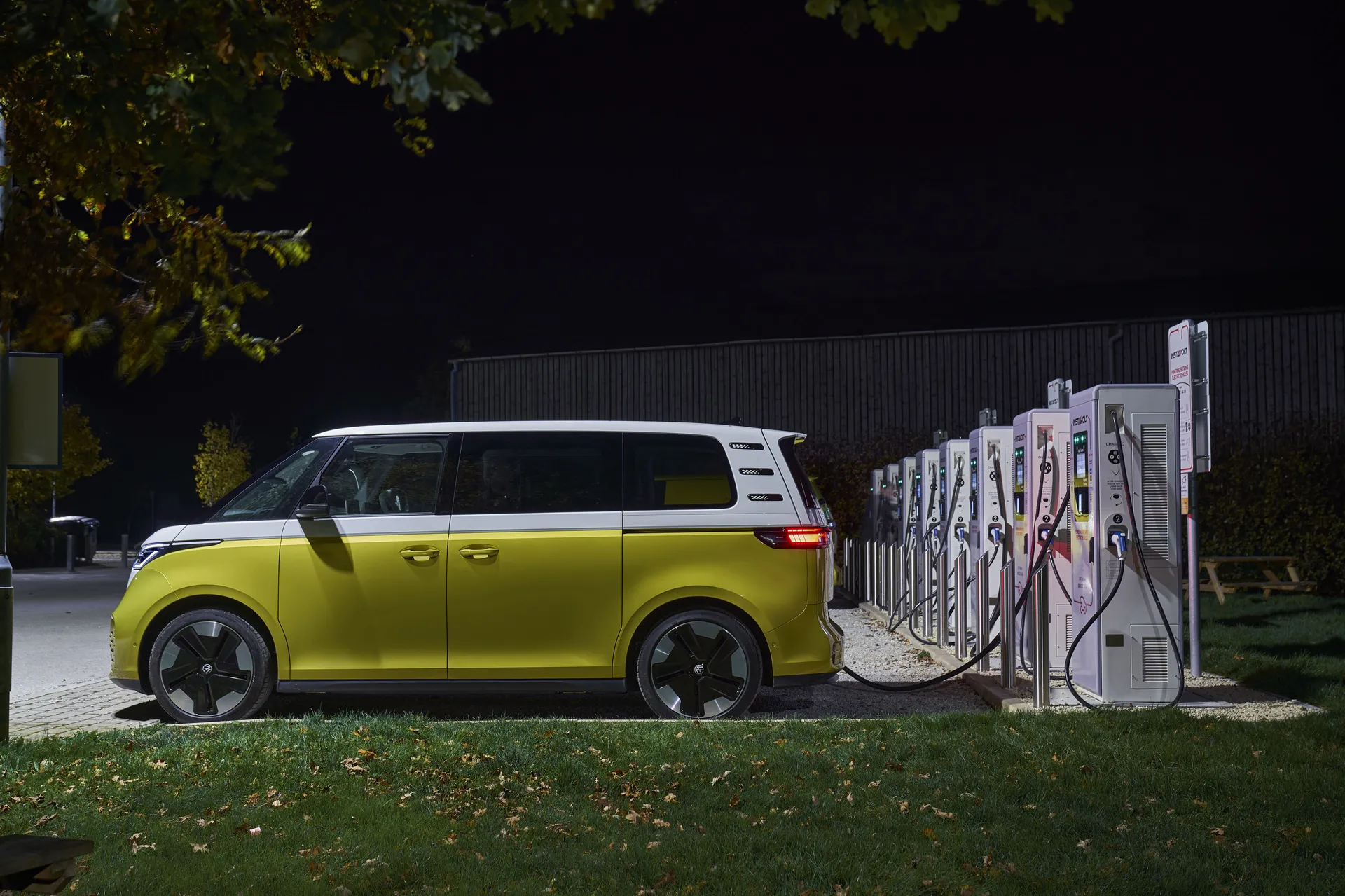
The 77kWh ID.Buzz offers DC rapid charging speeds of up to 170kW, enough for a 5-80% battery charge in about 30 minutes. It's the fastest charging speed VW offers on any of its electric models: even with the latest updates, the ID.3, ID.4 and ID.5 only manage speeds of up to 135kW.
On an AC charger, you'll get an output of up to 11kW from the ID.Buzz as things stand. As for how much it'll cost, that depends entirely on your home electricity tariff. If it's priced at the UK national average, a full charge will cost somewhere in the region of twenty quid, but getting yourself on a tariff that allows you to charge overnight at a discounted rate could easily cut that in half. The most expensive DC rapid chargers are around 70p per kWh as things stand, which means a cost of about £35-40 to go from 10-80%.
It's also worth pointing out that VW has taken a leaf out of Kia and Hyundai's book when it comes to 'bi-directional charging' being offered on the ID.Buzz. Essentially this allows the vehicle to feed energy from its batteries either into the domestic mains supply (say during a power outage) or to power household devices or even charge other EVs in an emergency.
How reliable is a Volkswagen ID.Buzz?
Early ID models (the Volkswagen ID.3 in particular) were plagued with glitches but VW seems to have got on top of these now. While it's still a fairly new model, we haven't heard of any issues with the Volkswagen ID.Buzz. Its simplicity ought to be on its side, too: electric cars have far fewer mechanical parts than combustion-engined cars, so are generally very reliable.
Like all Volkswagen models, the ID.Buzz comes with a warranty of three years/60,000 miles, which is pretty standard (if nothing particularly special). The battery is covered for up to eight years/100,000 miles, which ought to put your mind at rest if you're nervous about the longevity of your first electric car.
Insurance groups and costs
The Volkswagen ID.Buzz has been placed in insurance groups 31-33 (depending on specification), which means it should cost around the same to insure as a high-spec Volkswagen ID.4.
We have heard stories of some insurance companies charging more for electric vehicles but that's a practice that should become less frequent as EVs become more commonplace. It's always worth spending some time on insurance comparison sites before buying a new car, though, especially if you're a younger driver.
VED car tax: What is the annual road tax on a Volkswagen ID.Buzz?
Unlike petrol or diesel people carriers and vans, the Volkswagen ID.Buzz is currently exempt from road tax, and you won't even have to pay the usual premium car tax for vehicles with a list price of more than £40,000.
That's set to change, though, so don't buy an ID.Buzz for cheap road tax just yet. From 2025, electric cars will have to pay the same rate as petrol and diesel cars (currently £190/year after the first year), plus an extra £410/year in premium car tax.
How much should you be paying for a used Volkswagen ID.Buzz?
"With prices starting from around £60,000, you're clearly paying a premium for one of the market's most desirable electric cars. At least you get lots of standard equipment for your cash, though, while Volkswagen commercial vehicles tend to hold their value very well indeed."
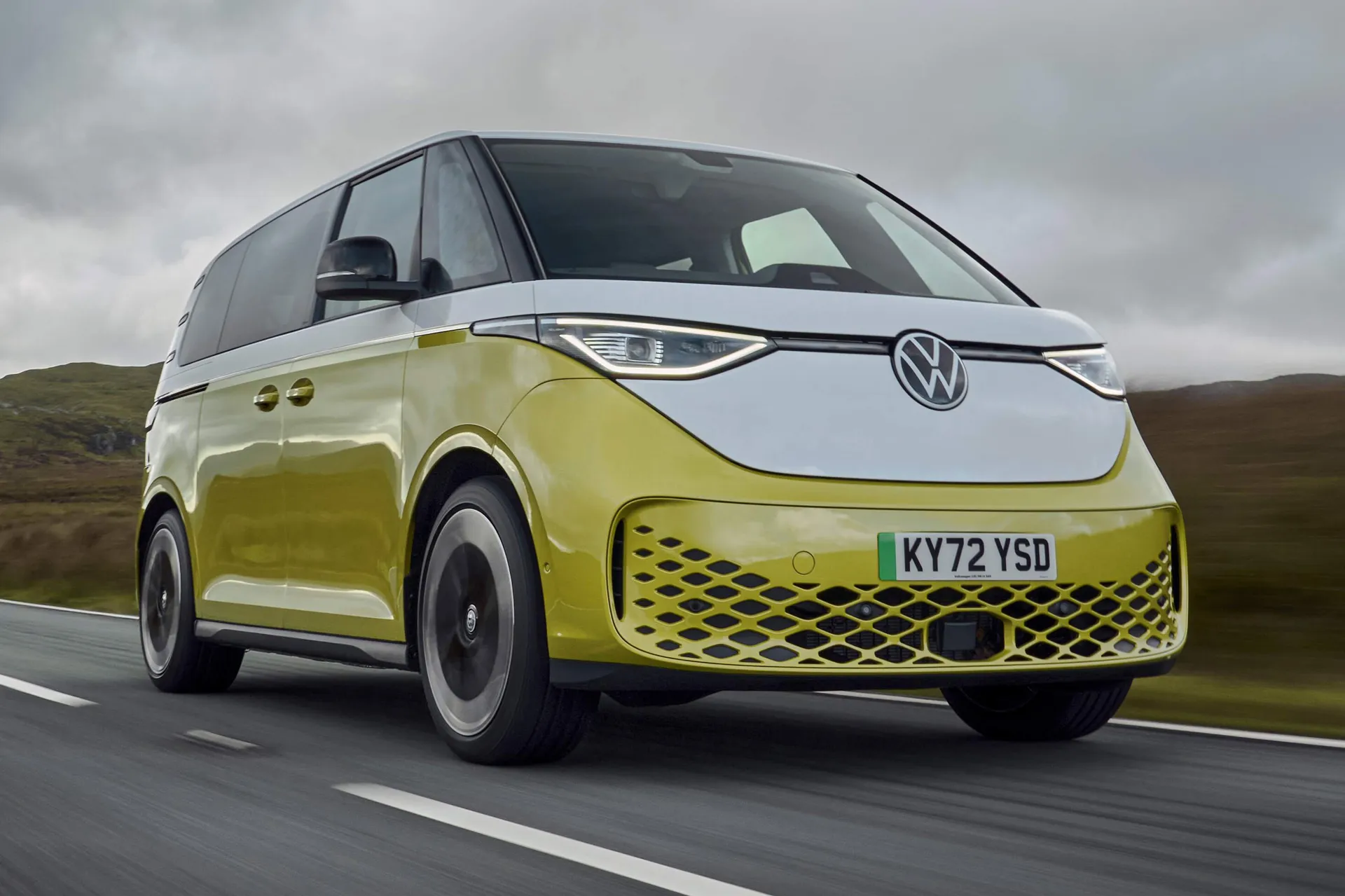
That's borne out by the heycar listings, which even now, don't have a great deal of choice for buyers of used ID.Buzz examples. Used prices also look to have barely come down, too, so the car is clearly rock-solid on the residual value front. That's good news for those that bought/buy brand new, but not great for anyone looking for a used ID.Buzz.
Trim levels and standard equipment
Standard equipment on the entry-level Volkswagen ID.Buzz Life includes LED headlights, illuminated door handles, sliding doors, privacy glass, gloss black door mirrors, 19-inch alloys, ambient cabin lighting, heated front seats, a heated faux leather wheel, sat-nav, wireless phone charging, voice control, front seat armrests, two-zone climate control, a heated windscreen, adaptive cruise control, an auto-dim rear view mirror, parking sensors all-round and a rear-view camera, keyless start and Park Assist.
Stepping up to the Volkswagen ID.Buzz Style brings further upgrades including IQ Light Matrix LED headlights with Dynamic Light Assist, LED rear light clusters, 20-inch alloys, 30 colour ambient lighting, decorative dash trims including a white dashboard, upgraded cloth seats, an electric tailgate and the multi-flex luggage board.
The Volkswagen ID.Buzz was briefly offered as a 1st Edition model with 21-inch alloys, upgraded Comfort front seats with electric adjustment and the upgraded 12-inch touchscreen infotainment system.
The GTX gets bespoke its own exterior styling treatment, an electrically dimmable panoramic glass roof, powered front seats and unique upholstery.
Ask the heycar experts: common questions
How much does a Volkswagen ID.Buzz cost?
Is the Volkswagen ID.Buzz a seven-seater?
What is the range of the Volkswagen ID.Buzz?
Get our latest advice, news and offers
Keep me updated by email with the latest advice, news and offers from heycar.
By submitting you agree to our privacy policy


